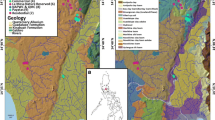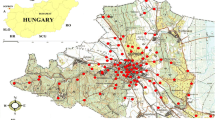Abstract
This study presents the current state of heavy metal contents in both urban and forest soils within the city area of Vienna, Austria. Based on a systematic survey of urban soils and on targeted sampling in forest areas, local and regional anomaly thresholds are derived using statistical methods and considering regional distribution patterns. For urban soils, local anomaly thresholds of elements Cu (60 mg/kg), Hg (0.5 mg/kg), Pb (100 mg/kg) and Zn (200 mg/kg) exceed national guideline values for uncontaminated urban soils and according to Austrian legislation fall into the category “anthropogenic contamination present but no damage to plants, animals or humans detectable”. In forest soils within the city, thresholds are very similar to reference values for similar geological settings outside the city, apart from higher concentrations of elements Cr and Ni (threshold values of 107 and 64 mg/kg, respectively). Grouping urban soils according to land use reveals that Cd contents are 25 % higher, Pb contents 36 % higher, in traffic and industrial areas than in parks and like Cu, Hg and Zn, these elements can be shown to be at least partly caused by anthropogenic contamination. A dependency between heavy metal concentrations in soils and underlying geological units is shown within the flysch zone at the western city margin where the contents of elements Co, Cr, Cu, Ni and V are controlled by geology and reveal distinct differences between geological units. In built-up areas, no clear dependency between heavy metal contents in soils and geology is evident as urban soils represent accumulations by anthropogenic activity rather than in situ weathering products of underlying sediments.





Similar content being viewed by others
References
Albanese, S., Cicchella, D., Lima, A., & De Vivo, B. (2008). Urban geochemical mapping. In B. De Vivo, H. E. Belkin, & A. Lima (Eds.), Environmental geochemistry: Site characterisation, data analysis and case histories (pp. 153–174). Amsterdam: Elsevier.
Birke, M., & Rauch, U. (2000). Urban geochemistry: Investigations in the Berlin metropolitan area. Environmental Geochemistry and Health, 22, 233–248.
Cheng, Q., Xu, Y., & Grunsky, E. (2000). Integrated spatial and spectrum method for geochemical anomaly separation. Natural Resources Research, 9, 43–56.
Cicchella, D., De Vivo, B., & Lima, A. (2005). Background and baseline concentration values of elements harmful to human health in the volcanic soils of the metropolitan and provincial area of Napoli (Italy). Geochemistry: Exploration, Environment, Analysis, 5, 1–12.
Eikmann, T., & Kloke, A. (2004). Nutzungs- und schutzgutbezogene Orientierungswerte für (Schad–)stoffe in Böden. Eikmann-Kloke-Werte. In: D. Rosenkranz, G. Einsele, & H. M. Harress (Eds.), Bodenschutz. Loseblattsammlung 3590. Berlin: Schmidt.
Fordyce, F. F., Brown, S. E., Ander, E. L., Rawlins, B. G., O’Donnel, K. E., Lister, T. R., et al. (2005). GSUE: urban geochemical mapping in Great Britain. Geochemistry: Exploration, Environment, Analysis, 5, 325–336.
Johnson, C. C., & Ander, E. L. (2008). Urban geochemical mapping studies: How and why we do them. Environmental Geochemistry and Health, 30, 511–530.
Johnson, C. C., Demetriades, A., Locutura, J., & Ottesen, R. T. (2011). Mapping the chemical environment of urban areas. Chichester: Wiley-Blackwell.
Kreiner, P. (2004). Wiener Bodenbericht 2003. Beiträge zum Umweltschutz, 70, Wien. http://www.wien.gv.at/umweltschutz/pdf/bodenber03.pdf.
Küpper, H. (1968). Geologie der österreichischen Bundesländer—Wien. Wien: Geologische Bundesanstalt.
Neinavaie, H. (2010). Datendokumentation Schwermineral- und Staubproben. In: S. Pfleiderer, A. Schedl, H. Neinavaie, & H. Pirkl (Eds.), Umweltgeochemie Stadtgebiet Wien. Vienna: Report of the Geological Survey of Austria.
Pfleiderer, S., & Hofmann, T. (2007). Digitaler angewandter Geoatlas—Stadtgeologie am Beispiel von Wien. Jahrbuch der Geologischen Bundesanstalt, 147, 263–273.
Pfleiderer, S., Schedl, A., Neinavaie, H., & Pirkl, H. (2010). Umweltgeochemie Stadtgebiet Wien. Vienna: Report of the Geological Survey of Austria.
Prey, S. (1973). Der südöstlichste Teil der Flyschzone in Wien, ausgehend von der Bohrung Flötzersteig 1. Verhandlungen der Geologischen Bundesanstalt, 1973, 67–94.
Reimann, C., Birke, M., & Filzmoser, R. (2011). Data analysis for urban geochemical data. In C. C. Johnson, A. Demetriades, J. Locutura, & R. T. Ottesen (Eds.), Mapping the chemical environment of urban areas (pp. 99–115). Chichester: Wiley-Blackwell.
Reimann, C., Filzmoser, P., & Garrett, R. G. (2005). Background and threshold: Critical comparison of methods of determination. Science of the Total Environment, 345, 1–16.
Reimann, C., Filzmoser, P., Garrett, R. G., & Dutter, R. (2008). Statistical data analysis explained. Sussex: Wileys.
Royden, L. H., Biddle, K. T., & Christie-Blick, N. (1985). The Vienna basin: A thin skinned pull apart basin. Strike slip deformation, basin formation and sediments. Society of Economic Paleontologists and Mineralogists. Special Publication, 37, 319–338.
Sajn, R., Bidovec, M., Andjelov, M., Pirc, S., & Gosar, M (1998). Geochemical atlas of Ljubljana and environs. Ljubljana: Geological, geotechnical and geophysical Institute.
Sarkar, D., Datta, R., & Hannigan, R. (2007). Concepts and applications in environmental geochemistry. Developments in environmental science (Vol. 5). Elsevier.
Schwarz, S., & Freudenschuss, A. (2004). Referenzwerte für Schwermetalle in Oberböden. Auswertungen aus dem österreichweiten Bodeninformationssystem Boris. Umweltbundesamt Monographie M-170. Umweltbundesamt Wien.
Thornton, I., Farago, M. E., Thums, C. R., Parrish, R. R., McGill, R. A. R., Breward, N., et al. (2008). Urban geochemistry: Research strategies to assist risk assessment and remediation of brownfield sites in urban areas. Environmental Geochemistry and Health, 30, 565–576.
van Dijk, D. (2002). Wageningen evaluating programmes for analytical laboratories (WEPAL): A world of experience. Communications in Soil Science and Plant Analysis, 33, 2457–2465.
Wessely, G. (2006). Geologie der österreichischen Bundesländer–Niederösterreich (p. 416). Wien: Geologische Bundesanstalt.
Wong, C. S. C., Li, X. D., & Thornton, I. (2006). Urban environmental geochemistry of trace metals. Environmental Pollution, 142, 1–16.
Wruss, W. (2004). Bodenuntersuchungen auf Wiener Kinderspielplätzen. Report of the Vienna Magistrate Department for Parks and Gardens. http://www.wien.gv.at/umweltschutz/pdf/spielplaetze.pdf.
Acknowledgements
This study was funded by the Federal Ministry for Science and Research and by the Vienna Municipal Administration. We are thankful to J. Auer (Municipal Department of Foundation Engineering) and G. Nagel (Municipal Department of Water Management) for supporting the study as well as to two anonymous reviewers for improving the manuscript.
Author information
Authors and Affiliations
Corresponding author
Rights and permissions
About this article
Cite this article
Pfleiderer, S., Englisch, M. & Reiter, R. Current state of heavy metal contents in Vienna soils. Environ Geochem Health 34, 665–675 (2012). https://doi.org/10.1007/s10653-012-9485-8
Received:
Accepted:
Published:
Issue Date:
DOI: https://doi.org/10.1007/s10653-012-9485-8




